AGRONOMICSUPPORT
YOU CAN TAKETO THE FIELD
West Tests: Unlocking Hybrid Potential Across Diverse Western Conditions
As a grower in the West, you know how much of a challenge — and reward — any particular growing season can be. The West is a unique region that contains a wide spectrum of landscapes, soil types, weather events, management practices, precipitation patterns and more. What works well for a farm in northern Nebraska might not work as well for a grower in western Iowa.
Keeping economic and agronomic opportunities and limitations in mind, every farmer is faced with navigating acres with ROI in mind. To achieve that ROI you need an ally to help you figure out those variables — and plant the best possible seeds on those acres.
That’s why LG Seeds, as your reliable partner in the field, performs “West Tests”: product tests that deliver powerful insights unique to specific geographies and environments that aren’t typically tested.
West Tests: what are they?
These observational plots help us gain valuable performance data about LG Seeds products. The tests help illuminate which products offer the best protection against diseases, weather conditions, high/low inputs and other stresses. It’s also a chance to see unique farming practices in action: which practices match well with which hybrids?
To get the best results, West Test plots are held to certain protocols. Plots are in uniform areas of the field, where row lengths and planting depth are as even as possible, and there are at least eight buffer rows on each side of the plot.
West Tests also include a specific planting order that can’t be deviated from. This helps ensure the clearest results that offer the most valuable insights about the products.
Here’s a peek into how West Test plots fared in 2023:
Dryland performance
These first tests in Nebraska featured lower populations and were in soils with less organic matter. The results would help determine which products could prove their water uptake efficiency in dryland environments.
One strong product that emerged in these dryland tests was LG64C90STX, offering better-than-expected yields. Meanwhile, LG62C07-3110 was the top performer. And LG66C44VT2 offered top-end yields providing an alternative to LG66C06VT2RIB which can require more management to hit those numbers.
These top hybrids displayed high efficiency in water usage uptake and an ability to perform consistently, even in inconsistent environments. Versatility of this kind is of high value to growers in the West.
On the other end of the spectrum, both LG58C48VT2 and LG58C73-3110 did not handle late heat stress as well, and shut down early. This is important to note if you grow in a region accustomed to higher temperatures late in the season.
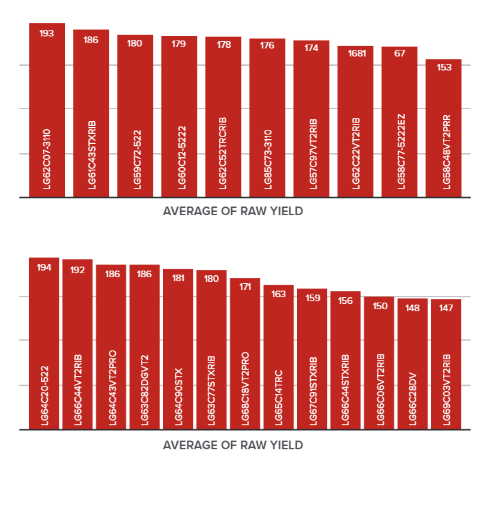
Irrigated, high management
Staying in the Cornhusker State, we also tested on irrigated acres. In these plots, the early-season products pollinated in cooler weather while the late-season hybrids flowered during a heat wave which created a drag on yields. With this extra water, plus high management, LG62C22VT2 stood out with big-time yields.
While LG64C43VT2 didn’t show up as well on dryland acres well, it did much better with irrigation showing up on the top of the charts.
LG61C34STXRIB found a way to reinforce its reliability by showing consistency in the prior dryland test as well as these irrigated scenarios.
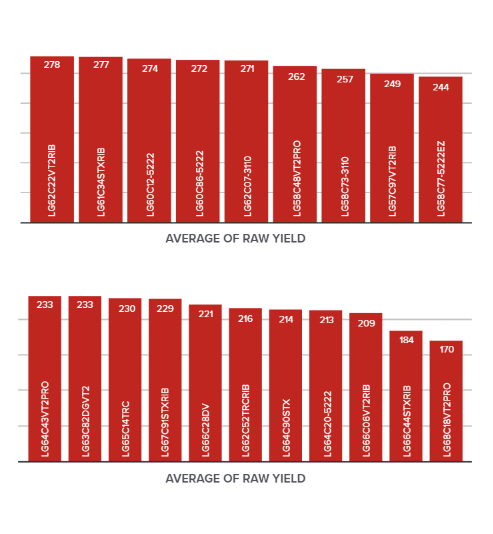
Observations of high pH environments
When it comes to the list of soil variables that can create stress for any farmer, high PH sits near the top of the list. These acres can be tough to plan around, especially with the added unknown of weather and environmental factors year-to-year.
In these observational plots, pH levels were consistently above 8, well above the prime level of 6.5. Higher levels restrict nutrient uptake, holding the plant back from its potential.
Across multiple growing stages, LG45C94VT2RIB maintained a visual advantage over other products. Whether it was V3-V4 or V9-V10, a denser green appearance proved the hybrid’s ability to counter the tough pH environment.
.png?sfvrsn=e5fe7a5d_1)
.png?sfvrsn=a30c2a9a_1)
.png?sfvrsn=7b14ffba_1)
.png?sfvrsn=3ee4b9a9_1)
High management vs low management
In Iowa, we set out to test which products performed well under various management conditions. We compared a high-management, high-fertility plot with a “normal input” plot. Both fields were under the same heat and drought stress.
The high-management scenario included conventional tillage, a corn-following-soybeans rotation, and fungicide at tasseling. Seed was planted at a 35,000 population.
In the normal input plot, minimum tillage was used, and the grower didn’t apply fungicide or any extra potassium and phosphorus. Seed was planted at a 32,000 population.
Ultimately, LG63C82DGVT2RIB was the big winner. Under high management, this hybrid had the highest yield, at 300 bu/a. But even under normal inputs, it still performed well, with 256 bu/a highlighting it’s reliability and versatility across these conditions.
Several other hybrids — LG64C90STX and LG62C22VT2 — had strong showings in both management scenarios as well.

The reliability of the three products across different levels of management can give farmers confidence in the West.
LG62C07-3110 was one that demonstrated a clear difference in results between the two scenarios. It performed well with high management, yielding 278 bu/a while yield dropped to 226 bu/a, with normal inputs. This demonstrated that with the right management yield can be pushed with LG62C07.
Late-season products on productive acres
If you’re a grower who plants late hybrids, you might want to pay attention to LG64C43VT2PRO. It’s shown excellent performance on productive ground, and this West Test plot about 45 minutes west of Kansas City proves that.
These acres feature healthy soil and about 14 inches of in-season rainfall. Planting population was 23,000 with an early May plant date. In this situation, LG64C43VT2PRO was the top yielder, at 217.4 bu/a. That’s far and away above the county average for this area: 125 bu/a.
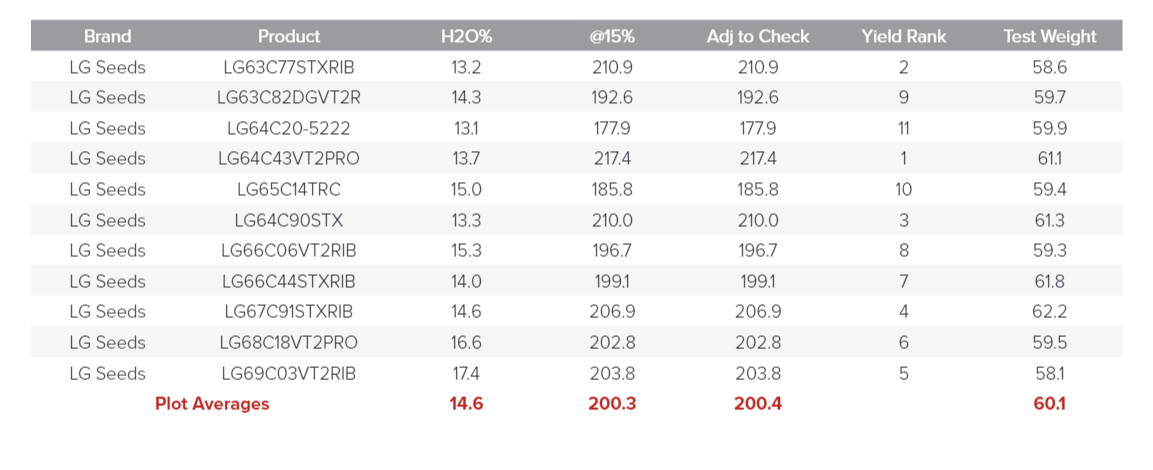
Other top performers among these late hybrids included LG63C77STXRIB and LG64C90STX, which both yielded at least 210 bu/a. These winning hybrids showed their ear flex abilities despite lower planting populations.
High-population and irrigated
These high management tests explored late-season hybrids with high populations. The new variables in this instance included a higher planting population and a stressful environment near Wichita, Kansas.
This plot was planted at a 35,000 population. And it helped demonstrate that there was no notable yield increase when planting that high of a population. For most hybrids, it’s not necessary to go over 32,000.
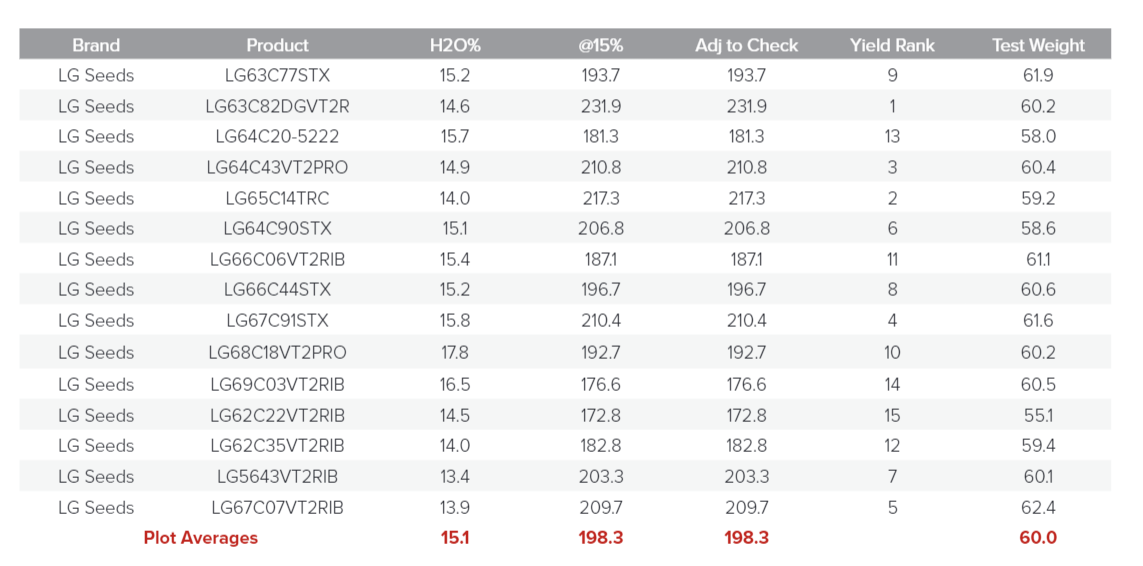
From this we learned that reaching above the 32,000 population mark didn’t increase yields significantly. The same products - LG63C82DGVT2R and LG64C34VT2PRO - continue to perform reliably in this environment as they do in many others.
Low-population& low pH
To test some of our late-season hybrids in a more stressful environment, we headed south to Oklahoma. This West Test plot was near Blackwell, which is about an hour south of Wichita, Kansas. Planting population was 20,000. In this region, rain can be scarce, and heat stress is real. How would LG Seeds' late-season products fare?
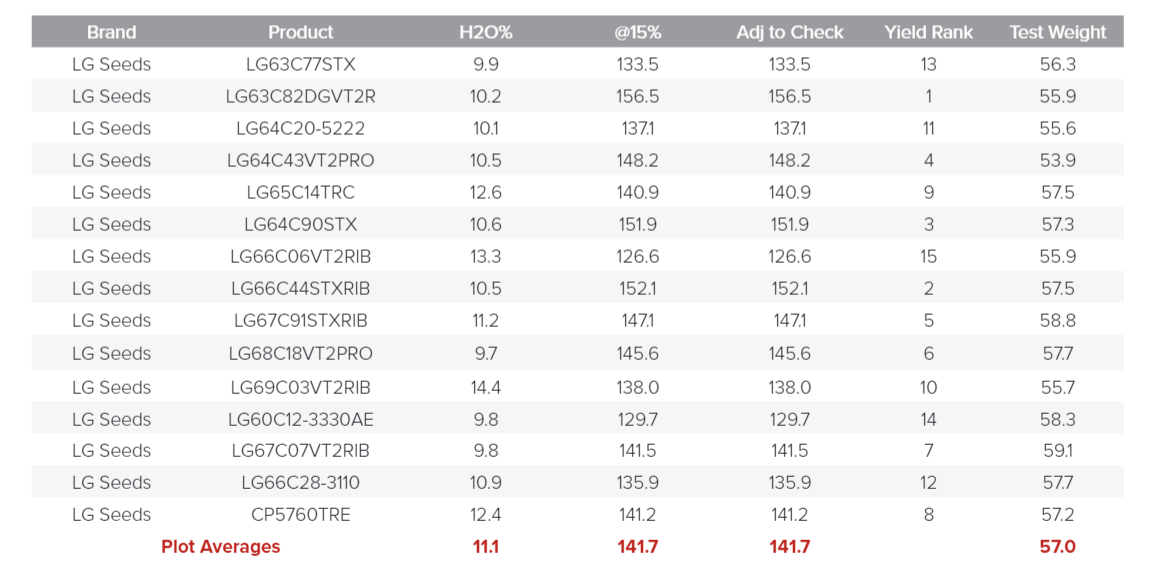
Mother Nature threw a curveball — and sent above-average rain to Oklahoma. The plot got about 15 inches in May and June, which is more than usual. Slightly lower pH also contributed to the outcome. The top performers from this West Test might not always be the most appropriate for every acre in the region. But on a well-managed, rainfed or irrigated acre, these products — including LG63C82DGVT2R, LG64C44STXRIB, LG64C90STX, and LG64C43VT2PRO — showed they can handle the heat stress well.
Marginal acres with low potassium
If you’re a grower in the West, you already know that many regions throughout the West include some tough acres. But one test plot about 45 minutes west of Kansas City demonstrated the power of LG Seeds’ germplasm when it comes to handling that stress.
This plot was on upland, marginal acres that showed some early-season potassium deficiencies. We were testing which mid-season hybrids could still perform in that kind of environment at a 24,000 population.

As you can see from the figure above, some of our key mid-season hybrids still showed strong yields despite the tough environment. LG59C72-5222 (162.7 bu/a) and LG60C86-5222 (159.1 bu/a) in particular were a cut above the rest.
The flex and toughness of these products on tougher acres speak to their reliability in a variety of scenarios in the West.
Progressive production at low population
We also tested mid-season and late-season hybrids on another dryland, upland plot in northeast Kansas, near Linn. With productive soils and a progressive operator, the plot was planted with a 24,000 population.
This region was hit with several stressors: hail damage so bad that the grower had to chop some of his irrigated fields for silage, then problems with green snap on these dryland acres.
However, LG61C34STX and LG67C91VT2 still performed even in difficult conditions and led the plot.
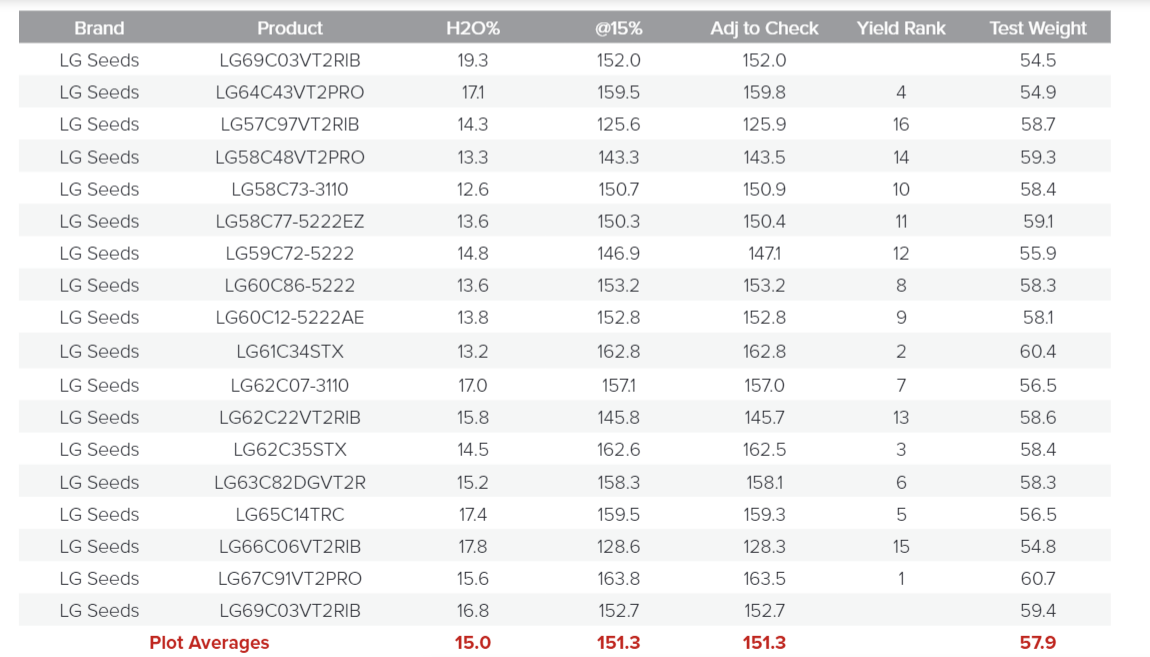
High pH & high elevation
These next tests took place in western Nebraska, western Kansas, and Colorado where high pH and elevation are the norm. We wanted to explore what hybrids with a non-traditional RM would preform in the area.
For a variety of soil types and management practices across the High Plains, LG42C80VT2RIB stood out as a great early-season option. It’s a new addition to the LG Seeds 92-Day maturity lineup and offers excellent grain quality on dryland and irrigated acres.
Other products like LG49C28VT2RIB and LG56C22SSP also showed their versatility in these tests.

High heat & drought in irrigated environments
For late season, LG64C43VT2RIB was — for the second year in a row — the yield champion in this region. This is due to its ability to grow in multiple soil types and its excellent tolerance of drought and heat stress. Additionally, it has shown excellent movement south into the Texas Panhandle. LG65C14TRC also had a strong showing, proving it’s ability in these arid environments.
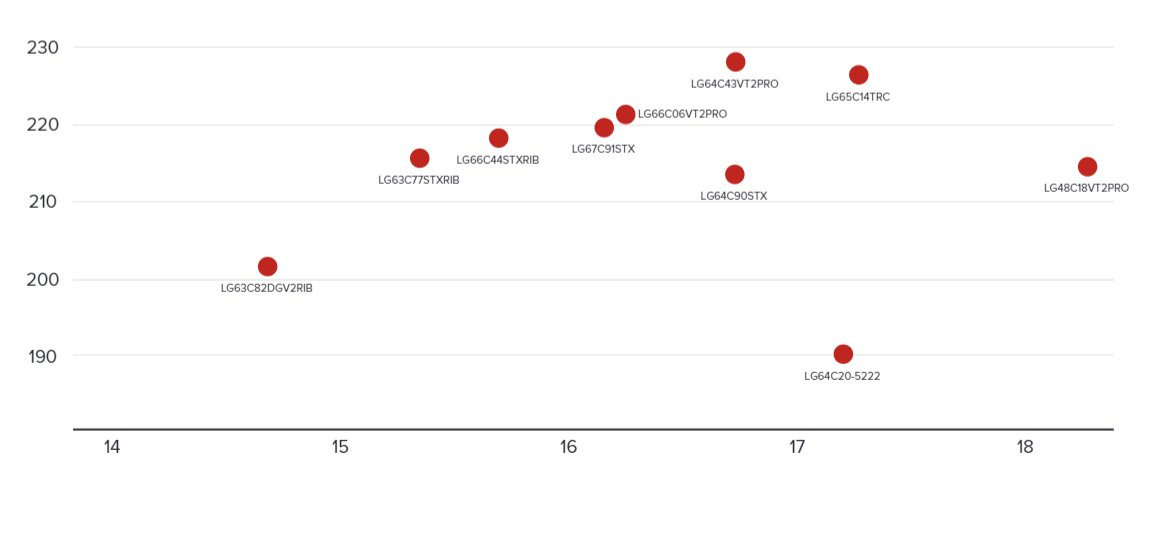
High heat & extreme drought
In the first batch of tests in western Iowa we explored the affect of high heat as well as extreme drought on products. What we discovered was that LG60C12-5222AEZ really soaked up the heat and performed well. The second plot saw more rainfall but still had the heat, and LG63C82VT2RIB was the clear winner.
Both products showcased their strong root structure in these tough circumstances highlighting their reliability across the region. This test highlighted how different a plant can react to heat versus drought, and how extensive environmental testing was the goal of these West Test experiments.

Whether you’re a grower on dryland acres in Kansas or you operate from irrigated fields in Iowa, West Tests offer valuable insight into which products can maximize your land and give you the best chance at strong yields in the West. Remember every acre counts and our goal is to help you get the most yield out of every acre on your operation.
For more support with choosing the best seed for your acres, contact your local LG Seeds agronomist.


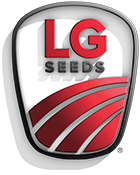

.png?sfvrsn=38af3f6d_1)

Agronomy Team